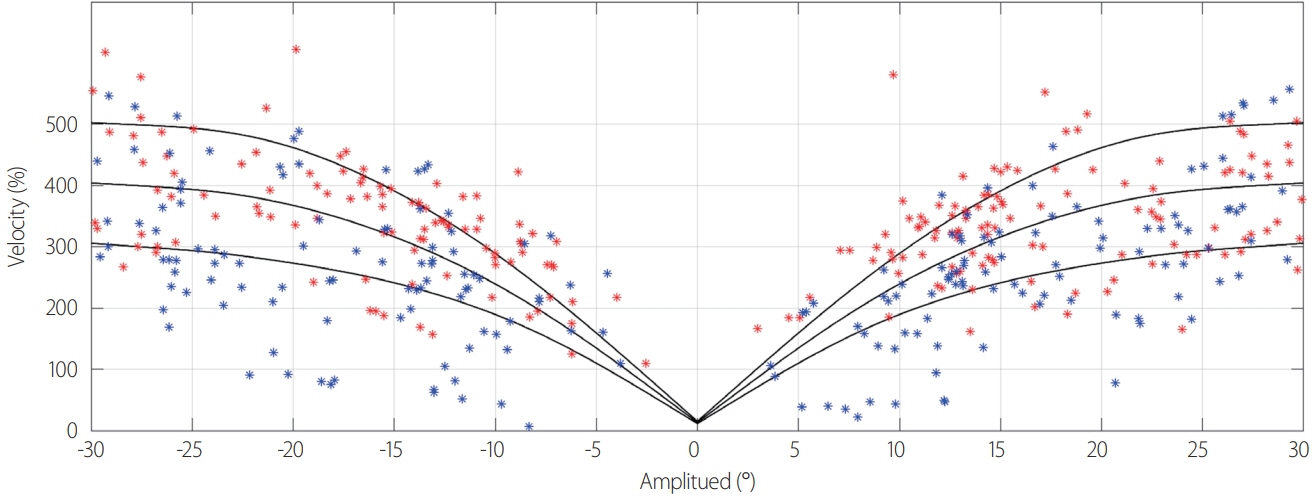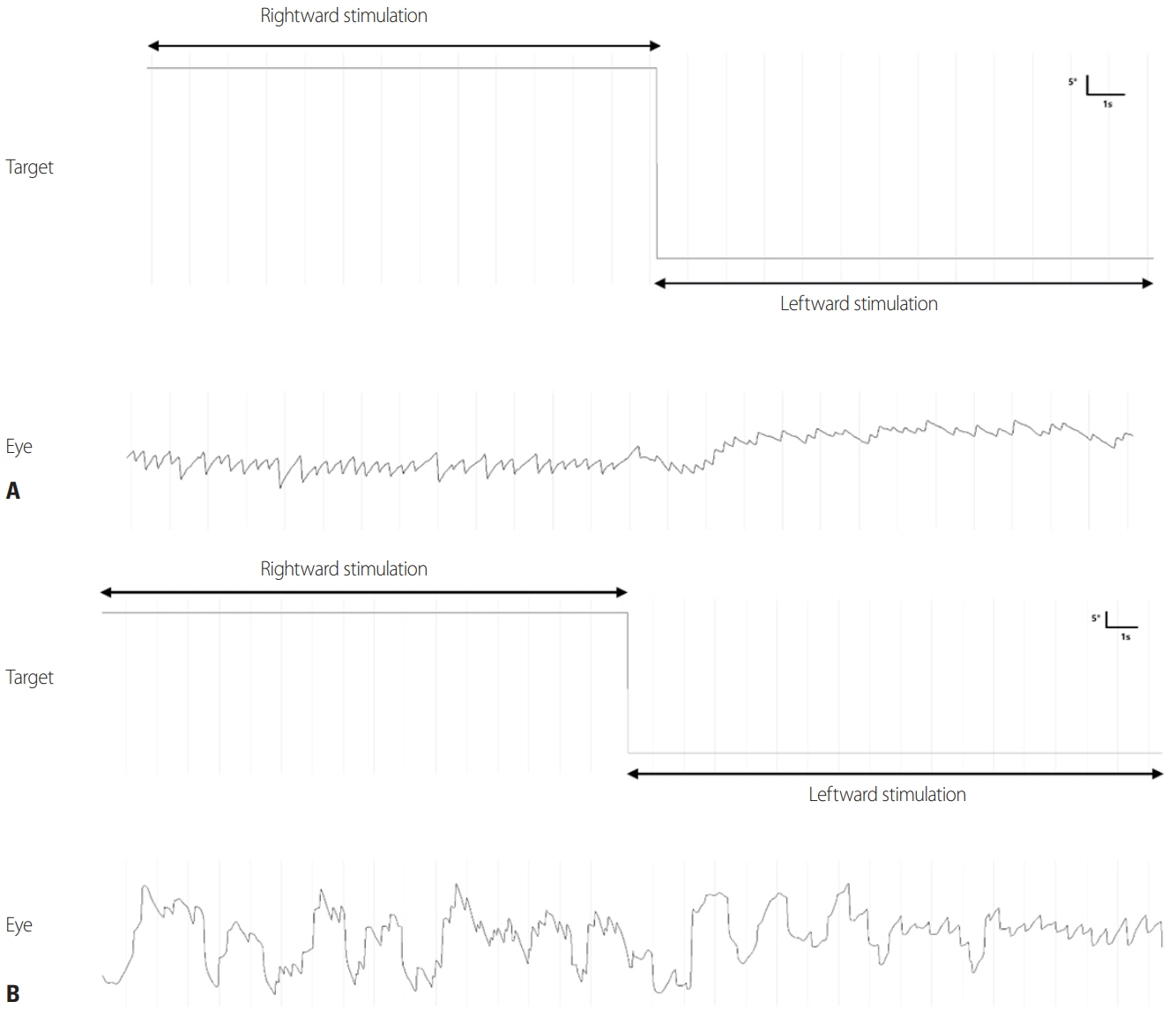Ann Clin Neurophysiol.
2023;25(2):55-65. 10.14253/acn.2023.25.2.55.
Recording and interpretation of ocular movements: saccades, smooth pursuit, and optokinetic nystagmus
- Affiliations
-
- 1Department of Neurology, Jeonbuk National University Hospital, Jeonbuk National University School of Medicine, Jeonju, Korea
- 2Research Institute of Clinical, Jeonbuk National University Hospital, Jeonbuk National University School of Medicine, Jeonju, Korea
- 3Department of Neurology, Korea University Medical Center, Seoul, Korea
- 4Department of Neurology, Chonnam National University Hospital, Gwangju, Korea
- KMID: 2547397
- DOI: http://doi.org/10.14253/acn.2023.25.2.55
Abstract
- The ultimate role of ocular movements is to keep the image of an object within the fovea and thereby prevent image slippage on the retina. Accurate evaluations of eye movements provide very useful information for understanding the functions of the oculomotor system and determining abnormalities therein. Such evaluations also play an important role in enabling accurate diagnoses by identif ying the location of lesions and discriminating from other diseases. There are various types of ocular movements, and this article focuses on saccades, fast eye movements, smooth pursuit, and slow eye movements, which are the most important types of eye movements used in evaluations performed in clinical practice.
Figure
Reference
-
1. Leigh RJ, Zee DS. The neurology of eye movements. 5th ed. New York: Oxford University Press;2015. p. 10–12.2. Westheimer G. Mechanism of saccadic eye movements. AMA Arch Ophthalmol. 1954; 52:710–724.
Article3. Davies R. Bedside neuro-otological examination and interpretation of commonly used investigations. J Neurol Neurosurg Psychiatry. 2004; 75 Suppl 4:iv32–iv44.
Article4. Zuma e Maia F, Ramos BF, Mangabeira Albernaz PL, Cal R, Schubert MC. An algorithm for the diagnosis of vestibular, cerebellar, and oculomotor disorders using a systematized clinical bedside examination. Cerebellum. 2021; 20:760–767.
Article5. Fischer B, Biscaldi M, Gezeck S. On the development of voluntary and reflexive components in human saccade generation. Brain Res. 1997; 754:285–297.
Article6. Ranalli PJ, Sharpe JA. Contrapulsion of saccades and ipsilateral ataxia: a unilateral disorder of the rostral cerebellum. Ann Neurol. 1986; 20:311–316.
Article7. Boghen D, Troost BT, Daroff RB, Dell’Osso LF, Birkett JE. Velocity characteristics of normal human saccades. Invest Ophthalmol. 1974; 13:619–623.8. Sharpe JA, Fletcher WA. Saccadic intrusions and oscillations. Can J Neurol Sci. 1984; 11:426–433.
Article9. Kassavetis P, Kaski D, Anderson T, Hallett M. Eye movement disorders in movement disorders. Mov Disord Clin Pract. 2022; 9:284–295.
Article10. Lemos J, Eggenberger E. Saccadic intrusions: review and update. Curr Opin Neurol. 2013; 26:59–66.11. Selhorst JB, Stark L, Ochs AL, Hoyt WF. Disorders in cerebellar ocular motor control. II. Macrosaccadic oscillation. An oculographic, control system and clinico-anatomical analysis. Brain. 1976; 99:509–522.12. Yee RD, Spiegel PH, Yamada T, Abel LA, Suzuki DA, Zee DS. Voluntary saccadic oscillations, resembling ocular flutter and opsoclonus. J Neuroophthalmol. 1994; 14:95–101.
Article13. Murphy BJ. Pattern thresholds for moving and stationary gratings during smooth eye movement. Vision Res. 1978; 18:521–530.
Article14. Tychsen L, Lisberger SG. Visual motion processing for the initiation of smooth-pursuit eye movements in humans. J Neurophysiol. 1986; 56:953–968.
Article15. Thier P, Ilg UJ. The neural basis of smooth-pursuit eye movements. Curr Opin Neurobiol. 2005; 15:645–652.
Article16. Mittelstaedt H. Theory of coordinate transformation by efference copy survives another attack. Behav Brain Sci. 1994; 17:269–270.
Article17. Miles FA. The sensing of optic flow by the primate optokinetic system. In : John MF, Robin W, Robert WK, editors. Studies in Visual Information Processing. 1st ed. Vol. 6. Durham (UK): North-Holland;1995. p. 47–62.18. Wyatt HJ, Pola J. Predictive behavior of optokinetic eye movements. Exp Brain Res. 1988; 73:615–626.
Article19. Cullen KE. Physiology of central pathways. Handb Clin Neurol. 2016; 137:17–40.
Article20. Maioli C. Optokinetic Nystagmus: modeling the velocity storage mechanism. J Neurosci. 1988; 8:821–832.
Article21. Kaneko CR. Eye movement deficits after ibotenic acid lesions of the nucleus prepositus hypoglossi in monkeys. I. Saccades and fixation. J Neurophysiol. 1997; 78:1753–1768.
Article22. Sharpe JA, Sylvester TO. Effect of aging on horizontal smooth pursuit. Invest Ophthalmol Vis Sci. 1978; 17:465–468.23. Kim JS, Sharpe JA. The vertical vestibulo-ocular reflex, and visual-vestibular interaction during active head motion. Ann N Y Acad Sci. 2002; 956:533–536.
Article24. Morrow MJ, Sharpe JA. Cerebral hemispheric localization of smooth pursuit asymmetry. Neurology. 1990; 40:284–292.
Article25. Komatsu H, Wurtz RH. Modulation of pursuit eye movements by stimulation of cortical areas MT and MST. J Neurophysiol. 1989; 62:31–47.
Article26. Bogousslavsky J, Regli F. Pursuit gaze defects in acute and chronic unilateral parieto-occipital lesions. Eur Neurol. 1986; 25:10–18.
Article27. Lekwuwa GU, Barnes GR. Cerebral control of eye movements. I. The relationship between cerebral lesion sites and smooth pursuit deficits. Brain. 1996; 119:473–490.28. Zackon DH, Sharpe JA. Midbrain paresis of horizontal gaze. Ann Neurol. 1984; 16:495–504.
Article29. Thier P, Bachor A, Faiss J, Dichgans J, Koenig E. Selective impairment of smooth-pursuit eye movements due to an ischemic lesion of the basal pons. Ann Neurol. 1991; 29:443–448.
Article30. Tarnutzer AA, Ramat S, Straumann D, Zee DS. Pursuit responses to target steps during ongoing tracking. J Neurophysiol. 2007; 97:1266–1279.
Article31. Carl JR, Gellman RS. Human smooth pursuit: stimulus-dependent responses. J Neurophysiol. 1987; 57:1446–1463.
Article32. Baloh RW, Yee RD, Honrubia V. Clinical abnormalities of optokinetic nystagmus. In : Lennerstrand G, Zee DS, Keller EL, editors. Functional Basis of Ocular Motility Disorders. 1st ed. Vol. 1. Oxford (UK): Pergamon;1982. p. 311–320.33. Brandt T, Allum JH, Dichgans J. Computer analysis of optokinetic nystagmus in patients with spontaneous nystagmus of peripheral vestibular origin. Acta Otolaryngol. 1978; 86:115–122.
Article34. Brantberg K, Magnusson M. Asymmetric optokinetic afterresponse in patients with vestibular neuritis. J Vestib Res 1990-. 1991; 1:279–289.
Article35. Zasorin NL, Baloh RW, Yee RD, Honrubia V. Influence of vestibulo-ocular reflex gain on human optokinetic responses. Exp Brain Res. 1983; 51:271–274.36. Zee DS, Yee RD, Robinson DA. Optokinetic responses in labyrinthine-defective human beings. Brain Res. 1976; 113:423–428.
Article
- Full Text Links
- Actions
-
Cited
- CITED
-
- Close
- Share
- Similar articles
-
- Clinical significance of saccade test, smooth pursuit test, and optokinetic nystagmus test in nystagmography
- Abnormal Eye Movements in Parkinsonism and Movement Disorders
- Neuro-Behcet's Disease Presenting with Foville Syndrome : A Case Report
- Clinical and Oculographic Findings of X-linked Congenital Nystagmus in Three Korean Families
- Clinical Studies on Electro-Oculography: Quantitative analysis of Smooth pursuit, OKN, and Bithermal Caloric test







